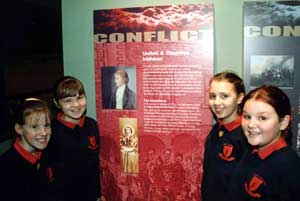18 December 2003 Edition
Ulster Museum launches Irish at War exhibition

Jamie Leigh McAleese, Kirsty Conlan, Gael Conlan and Danielle Tierney from Vera Fosta School
The Ulster Museum, on Belfast's Stranmillis Road, launched its latest exhibition, Conflict: The Irish at War, last Friday 12 December.
Exploring almost 10,000 years of life in Ireland, the exhibition looks at the violence and conflict that has been such a central and dynamic force in our history over the centuries. Indeed, the violence of occupation and the resistance to that occupation has been the main ingredient in the formation of modern Ireland and the Irish nation.
The exhibition boasts artifacts that date from the Mesolithic era to the present day, thus showing just how the implements of war have grown in sophistication from era to era and war to war.
The skeleton of a warrior, minus the skull, who was killed in battle and whose head was cut off for a trophy, is testament to the harsh reality of violence.
Among the artifacts are Stone Age arrowheads, Viking swords as well as swords and helmets from the doomed Spanish Armada.
Not alone did the wars in Ireland exact a price on the Irish and the British but also on those Europeans who, for whatever reason, become embroiled in the Irish conflict.
From the 1798 Rebellion, there is the uniform worn by Henry Joy McCracken and from the last century there is an original copy of the 1916 Proclamation, alongside a Mauser Rifle smuggled into Ireland by the UVF.
There are also plenty of items from the last 35 years. On display are an RUC helmet and shield damaged during the street fighting in Derry in 1969 and British Army rubber bullets.
The exhibition also has an old bin lid which, according to Trevor Parkhill, the keeper of history at the Museum, had a lot of young people who grew up in the era of the wheelie bin baffled. They thought the humble bin lid was some sort of ancient shield!
A central theme of the exhibition is commemoration and closure and to that end there is a section with exhibits dealing with the disappeared, the re-interment of Volunteer Tom Williams in January 2000 and a photo collage of the 302 RUC members killed over the last three decades.
Running alongside the exhibition is the Voices Project, which has people commenting on the various exhibits. As well as the more 'famous' of these contributors, who include former hunger striker Laurence McKeown and Colin Parry, whose son was killed by an IRA bomb in Warrington, schoolchildren from schools in Belfast, Antrim and Randalstown have their say.
These voices can be heard as part of the interactive aspect of the exhibition, which includes a computer section where the visitor can explore film and sound archives.
The exhibition is set to run for a year and the Ulster Museum hopes to draw 40,000 visitors.
The exhibition is a valuable exploration of the central role that violence and conflict has played in our history and no doubt will evoke different emotions in people from the various backgrounds who visit.
And while it will be up to each of us to draw our own meanings and apply our own analysis, it is my view that, regardless of our political persuasion, it tells us that we all inflicted violence on each other and no amount of retreating to the moral high ground will change that fact.
BY PEADAR WHELAN
